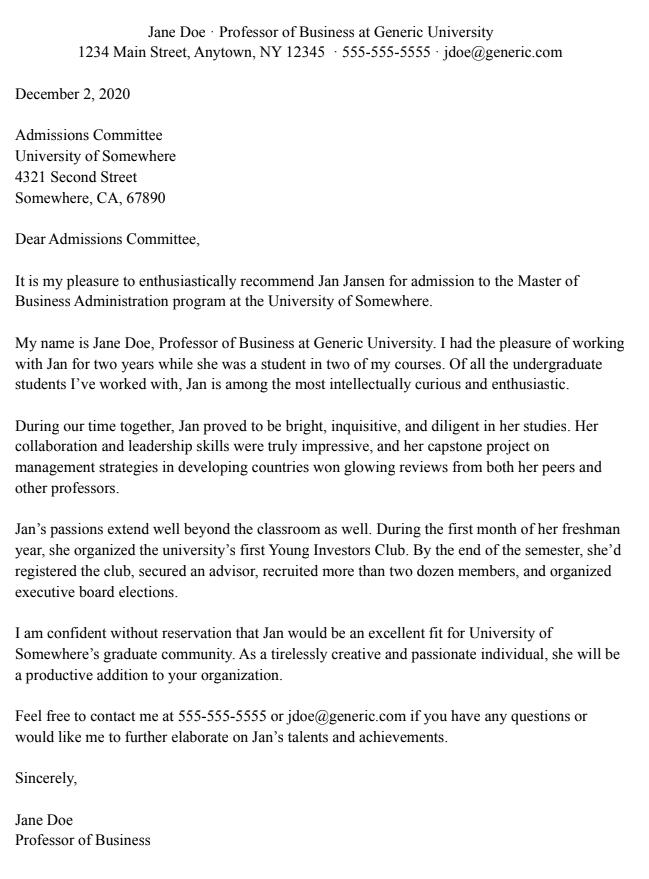13 Tips for Writing Recommendation Letters + Templates
Estimated reading time: 14 minutes
Writing a letter of recommendation is an excellent opportunity to show appreciation for a former employee or student’s hard work. It also allows you to express your gratitude to the applicant for their efforts and abilities. Taking the time to write a well-crafted letter is essential as it can significantly impact a candidate’s chances of getting a job or getting accepted into a college program. In this article, we define what a letter of recommendation is and provide 15 tips for writing a strong one..

What is a letter of recommendation?
If you want to express your gratitude towards a former colleague or a student for their hard work, you can write a letter of reference for them. It not only shows appreciation but also allows you to acknowledge the candidate’s skills and abilities. However, writing a letter of reference that can make a positive impact on a candidate’s job application or college enrollment requires time and effort. This post defines what a recommendation letter is and provides you with 15 tips to create a strong one..
Tips for writing a letter of recommendation
You can use the advice in the following list to help you as you write a letter of recommendation.
1-Create a new letter of recommendation
While a basic template on hand can be useful, make sure to personalize each letter with details highlighting the candidate’s qualifications. Before you start, try to jot down a general outline to ensure you do not forget to cover any important points about the candidate’s qualifications.
2- Review the resume
Review the applicant’s or student’s resume before you start writing to understand the range of experiences they have had in previous positions. By thoroughly understanding their background, you can write a more thorough letter that addresses their strengths and the specific goals they’re working toward. You could also examine potential improvement areas and offer the candidate or student edits.
3- Request some bullet points
Ask the candidate to provide bullet points or a few paragraphs that you can refer to save time and ensure you cover the topics they feel are most important for the position. They may give you a letter draught that you can edit and personalize.
4- Prepare a list of qualities
Make a list of the traits and achievements that, in your opinion, best demonstrate the applicant’s qualifications as you go over the resume and job description. Additionally, you might ask the applicant to list their most marketable qualities for the kind of work they want to do, particularly any that you may have noticed in the position they held when they were cooperating with you.
5- Introduce yourself
In the first few lines of the letter, it’s usually a good idea to introduce yourself. Explain your role and connection to the candidate in one or two short sentences. Even though it’s not required, providing specifics about your background will help put the letter in context and highlight why you are qualified to recommend this person.
6- Focus on one or two qualities
Choose one or two characteristics that, in your opinion, make the applicant a good fit for the job. Provide examples of the candidate exhibiting those traits to back up those claims. For instance, discuss how they overcame difficulties or challenges to achieve their objectives. For the letter’s main body, you might want to use two paragraphs, one focusing on a specific accomplishment and the other discussing the recipient’s character and traits like tenacity, integrity, work ethic, or personal standards.
7- Quantify the strengths
Please find below a revised version of the text you provided:
When writing a recommendation or reference letter for a candidate, it is helpful to provide specific examples of their strengths. If possible, try to quantify their advantages or compare them to other candidates or coworkers. For example, you could say “She possesses exceptional analytical skills that surpass anyone I have worked with during my ten years at the company” or “He was one of the most intelligent students I have had in my classes during my 17 years of teaching.” It is also useful to mention measurable outcomes the candidate achieved while working with you. For instance, you could say “He played a crucial role in increasing website traffic by 25% over six months, leading to a 10% rise in sales.”
8- Discuss their potential
Include your thoughts on why you think the applicant would succeed in the position given a chance in the letter. You might want to mention the following:
- Ability to work as part of a team
- Ability to work independently
- Strengths, skills, and talents you believe will position them for future success
9- Be enthusiastic
Your objective is to make the applicant stand out from the competition for the position or college program they are applying to. Express your excitement about how perfect you think they would be for the position. One simple way to accomplish this is to state in the letter that you would be happy to hire the person again within your department.
10- Include your contact information
Specify how the prospective employer or admissions office can get in touch with you for more information or with any queries they may have about the applicant. Mention that you would be happy to provide more information about the candidate’s qualifications. Your email address and phone number can be put at the end of the letter or right after your signature.
11- Proofread
It is crucial to proofread the letter to prevent typos and grammatical errors thoroughly. You might even want to read the letter out loud to avoid skimming words and missing potential mistakes.
12- Use the right format and length
Use a standard font and print size when writing your letter; typically, printed letters should be written in Times New Roman 12-point, or electronically submitted letters should be written in Arial 11-point. Make sure the margin is approximately one inch wide if you plan to print. The length should range from two-thirds to one full page of single spacing.
13- Follow the submission guidelines
Find out the candidate’s preferred method of letter submission. Make sure to adhere to any special instructions, such as the required letter format and the address to which the letter should be sent. Please be mindful of the approaching deadline.

Make Your Structure Simple.
Use the following basic format to organize your letter:
- Salutation: If you are writing to a particular person, start your letter with “Dear Mr./Ms./Dr. [name]:.” Avoid using a salutation if you’re writing a general letter or just write, “To Whom it May Concern:”
- Introduction: Explain the letter’s purpose and how you came to know the person you recommend in the first paragraph. You might also want to mention how long you’ve known the person.
- Details: The second paragraph explains why you think the recommended person is qualified for the position or program. Give specific examples that illustrate their qualifications and skills. If necessary, you can go into more detail about their credentials in more than one paragraph.
- Summary: List the main points of your recommendation in this section. You might say something like, “highly recommend” or “recommend [name] without reservation for [program/role].”
- Conclusion: In the final sentence, you should make the offer to speak with them further to provide more details about the applicant’s qualifications and skills. If you are writing to someone whose name is on the letter, sign off with “Yours sincerely” or “Yours faithfully” if you are unsure of the recipient.
- Sign the letter: Put your name and position at the end of the letter. Put your signature under the typed name if you print the letter and mail it.
A letter of recommendation is written on behalf of a candidate by someone who can attest to that candidate’s abilities in the classroom or on the job. This letter of recommendation is typically sent to a hiring manager or admissions officer who is evaluating a potential employee, intern, or scholarship applicant.
Recommendation letters complete an application. They provide information about a candidate’s character traits, such as integrity, intellectual zeal, or leadership potential. A strong letter of recommendation from a professor, therapist, manager, or coworker can help an applicant stand out from the crowd.
Letter of Recommendation Sample Download For Free
These are the samples of recommendation letters exclusively composed and edited by GrantUnity Team. Note that these samples are only to represent how the recommendation letter should be written, how many words the applicant should use, and where you should refer to your previous academic or professional background. Please do not exactly use these words and strive to make your unique recommendation letters to raise your chance while applying.

Frequently Asked Questions: Letter of Recommendations
The best and most obvious option is a professor who has been impressed by your academic performance and has given you a good grade in a class (or better yet, more than one class). The professor should ideally be able to comment on your personality and creativity. The professor of a seminar course is a good option, but any upper-level course (especially one requiring a paper) should give you a good opportunity to stand out and forge the kind of connection that will lead to an excellent letter of recommendation.
During office hours, you can speak with the professor in person. If you are writing from out of town, only send an email. However, you should not leave a note stating, “I need 3 letters to 3 different universities by Friday” in their mailbox or office door. You should email them to make an appointment if your schedule does not permit you to drop by during their business hours. Be formal and well-spoken when writing to a professor; if they don’t know you well, mention the course(s) you took with them rather than assuming they will remember you by name. It would be beneficial to bring a copy of any papers you have written for the class to your meeting or to mention them in your writing.
You need three letters of recommendation from people who are familiar with your academic credentials. Recommenders should be chosen from those who are most knowledgeable about your past coursework, research interests, or body of work, with at least one instructor from the most recent institution you attended included. The Graduate School prefers letters of recommendation from professors who are acquainted with your work in the area you intend to study. A letter from your boss or employer is required if you have been out of school for a while. Following are some exceptions to the rule requiring three letters of recommendation: (1) Two references are needed for the advanced certificate program in ergonomics, but they are not required to write letters of recommendation.
We advise you to contact your recommenders before asking for a recommendation. Tell them about the program you’re applying to and your academic aspirations. Tell them when applications for your program are due as well. Then, you will have the chance to include a brief personal note for each recommender when you submit your request for a recommendation in your application. We advise you to thank them for writing the letter on your behalf and informing them of the program you are applying to and the submission deadline.
You cannot order a letter through the online system if the person writing your recommendation does not have an email address. You should request that they mail in their recommendation since you cannot accept it in person. To continue, refer to the response to question 3 above. Additionally, kindly write a succinct explanation of the problem and upload it in the Additional Information section of your application along with the recommender’s name, organization/affiliation, position/title, relationship, and contact information.
The number of recommendation letters that are required or accepted can vary depending on the program or opportunity you are applying for. Some programs may only require one or two letters, while others may accept more. However, it is important to carefully review the application instructions to determine how many recommendation letters are required and who should write them.
If you have more than three recommenders, you can check the application instructions to see if there are any specific requirements or guidelines regarding the number of letters that can be submitted. In some cases, you may be able to submit additional letters, but it is important to make sure that these letters provide valuable information and are relevant to the program or opportunity you are applying for.
If the program or opportunity does not specify the number of recommendation letters, it may be appropriate to submit more than three letters if you feel that the additional letters provide valuable information about your academic potential, character, or relevant experiences. However, it is important to keep in mind that the quality of the letters is more important than the quantity, so you should choose your recommenders carefully and make sure that the letters are well-written and provide a clear picture of your strengths and potential.
It is generally advisable to submit your application as soon as possible, even if all of your letters of recommendation have not yet been submitted. This is because application deadlines are often firm, and submitting your application late could disqualify you from consideration.
Instead, you should check the application instructions to see if there are any specific deadlines for recommendation letters and make sure that your recommenders have ample time to write and submit their letters before the deadline. It is a good idea to reach out to your recommenders well in advance of the deadline and provide them with all of the necessary information and materials, such as the application deadline, a list of the programs or opportunities you are applying for, and a copy of your resume or academic transcript.
If you are concerned that one or more of your recommenders may not be able to submit their letters by the deadline, you can reach out to the program or opportunity to ask if there is any flexibility in the deadline. However, you should do this well in advance of the deadline and provide a clear explanation for why you are unable to meet the original deadline. In general, it is best to plan ahead and make sure that your application, including all of your recommendation letters, is submitted well before the deadline to avoid any last-minute stress or complications.
No. We advise you to ask for recommendations before submitting your application. When you ask for a recommendation, the person who will provide it will get an email with instructions for logging in and submitting the recommendation on your behalf. Once they submit the letter, it will be added to your application file.
There won’t be a problem, I assure you. As soon as you submit the letters, they will be added to your application record.
There will not be a problem, I assure you. As soon as you submit the letters, they will be added to your application record.
You have the option of reminding your recommender. This is done on your page for letters of recommendation. Click “Edit” after selecting the recommender, then “Send Reminder.”
A “spam” filter typically blocks the notification email as part of their email software, which is the main cause of a recommender not receiving the registration email. Please request that your recommender check both their inbox and spam folder for an email from “NYU GSAS Operations” with the subject line “Letter of recommendation request for Your Name,” where Your Name is the name that appears on your online application.
You can resend the registration email message to your recommender if they cannot locate it or if they unintentionally deleted it. This is done on your page for letters of recommendation. Click “Edit” after selecting the recommender, then “Send Reminder.” You can still do this if you’ve already submitted your online application.
Please ask your recommender if they have an alternative email address if the email message is still not received after two attempts. Send a request to them at the new email address by clicking the “Add Recommender” link. Additionally, you can “Edit” and then “Exclude” the first failed email listing.
After making those attempts, you will need to request that they mail the recommendation if the email message is still not received. Please review the response to query 3. (above).
By visiting your application status page and looking at the Application Checklist section, you can see the current status of your recommendations. You can see if a recommendation was “submitted” beneath each recommender’s name. A green check mark and the status “received” will also be displayed.








Leave a Reply
Want to join the discussion?Feel free to contribute!